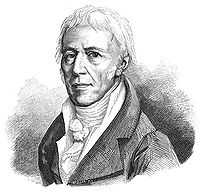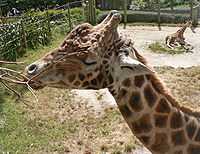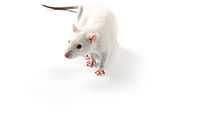Lamarckism

"Lamarckism (or Lamarckian inheritance) is the idea that an organism can pass on characteristics that it acquired during its lifetime to its offspring (also known as heritability of acquired characteristics or soft inheritance). It is named after the French biologist Jean-Baptiste Lamarck (1744–1829), who incorporated the action of soft inheritance into his evolutionary theories."[1]
After "Erasmus Darwin wrote Zoonomia suggesting "that all warm-blooded animals have arisen ... with the power of acquiring new parts" in response to stimuli, with each round of "improvements" being inherited by successive generations", "Jean-Baptiste Lamarck repeated in his Philosophie Zoologique of 1809 the folk wisdom that characteristics which were "needed" were acquired (or diminished) during the lifetime of an organism then passed on to the offspring."[1]
"Neo-Lamarckism is a theory of inheritance based on a modification and extension of Lamarckism, essentially maintaining the principle that genetic changes can be influenced and directed by environmental factors."[1]
Theory of Lamarckism
Def. "[t]he theory that structural variations, characteristic of species and genera, are produced in animals and plants by the direct influence of physical environments, and especially, in the case of animals, by effort, or by use or disuse of certain organs"[2]
"Lamarck incorporated two ideas into his theory of evolution, in his day considered to be generally true:
- Use and disuse – Individuals lose characteristics they do not require (or use) and develop characteristics that are useful.
- Inheritance of acquired traits – Individuals inherit the traits of their ancestors."[1]
Laimology

"Examples of what is traditionally called "Lamarckism" would include:
- Giraffes stretching their necks to reach leaves high in trees (especially Acacias), strengthen and gradually lengthen their necks. These giraffes have offspring with slightly longer necks (also known as "soft inheritance").
- A blacksmith, through his work, strengthens the muscles in his arms. His sons will have similar muscular development when they mature."[1]
"The giraffe's neck supposedly supplies a crucial example for preferring natural selection over Lamarckism as a cause of evolution. But Darwin himself (however wrongly by later judgement) did not deny the Lamarckian principle of inheritance for characters acquired by use or lost by disuse. He regarded the Lamarckian mechanism as weak, infrequent, and entirely subsidiary to natural selection, but he accepted the validity of evolution by use and disuse. Darwin does speculate about the adaptive advantage of giraffe's necks, but he cites both natural selection and Lamarckism as probable causes of elongation."[3]
"Henry Fairfield Osborn, the dominant paleontologist of his era, and long time director of the American Museum of Natural History, gave the "standard version in his popular book of 1918, The Origin and Evolution of Life... "Lamarck attributed the lengthening of the [giraffe's] neck to the inheritance of bodily modifications caused by the neck-stretching habit. Darwin attributed the lengthening of the neck to the constant selection of individuals and races which were born with the longest necks. Darwin was probably right." ...The version has held ever since."[3]
Epigenetics
"[I]nterest in Lamarckism has recently increased, as several studies in the field of epigenetics have highlighted the possible inheritance of behavioral traits acquired by the previous generation."[1]
"First, there is no reason to think that epigenetic variations are rare: when actively sought, they have usually been found. Second, epigenetic variations can be transmitted very stably, certainly in cell lines. ... Third, epigenetic inheritance is not limited to multicellular organisms: it is found in unicellular organisms too. ... Fourth, several different models have shown how, in certain conditions, transmitting some (not all) epigenetic variations from one generation to the next is a selective advantage, even if they are stable for only a few generations. ... Fifth, epigenetic variations may influence the site and nature of genetic changes and affect evolution in this way. ... [T]here is a Lamarckian component in evolution, with the environment being an inducer as well as a selector of variation."[4]
Hypertrophy
"The inheritance of acquired traits, also known as his 'Second Law' in Philosophie Zoologique, is the idea that the traits of an organism that undergo hypertrophy will be inherited by the next generation. This hypertrophy suggests an adaptation to the environment that can be passed on to the next generation through the genetic code of the organism."[5]
"The Lamarckian view of evolution is seen as a tendency for a species to reach perfection where it is actually simply adapting to their environment in a single generation."[5]
Transmissions
""The development of organs and their power of action are continually determined by the use of these organs." This is known as his [Lamarck's] third law. In the fourth he insisted on the hereditary nature of the effects of such use. "All that has been acquired, begun or changed," he said, "in the course of their life is preserved in reproduction and transmitted to the new individuals which spring from those which have experienced the changes.""[6]
Extinctions
"Lamarck did not believe that a species could become extinct. Instead, he saw the idea of extinction as every member of a species evolving into another species. He believed that change was brought about through use and disuse and inheritance of acquired characteristics. This was the first time that a mechanism was proposed in order to explain how a change in a species occurred."[5]
Mutations
"Lamarck was a believer in immutability."[5]
Lysenkoism
"The Lamarckism presented in standard textbooks is actually Lysenkoism, a straw man set up by the opponents of Lamarckism, palpably false and easily disproved."[7][8]
"Lysenko did not apply actual science. He was a proponent of the ideas of Ivan Vladimirovich Michurin, and practiced a form of Lamarckism, insisting on the change in species among plants through hybridization and grafting, as well as a variety of other non-genetic techniques. With this came, most importantly, the implication that acquired characteristics of an organism — for example, the state of being leafless as a result of having been plucked — could be inherited by that organism's descendants."[9]
Orthogenesis
"Orthogenesis, orthogenetic evolution, progressive evolution or autogenesis, is the hypothesis that life has an innate tendency to evolve in a unilinear fashion due to some internal or external "driving force". The hypothesis is based on essentialism and cosmic teleology and proposes an intrinsic drive which slowly transforms species. George Gaylord Simpson (1953) in an attack on orthogenesis called this mechanism "the mysterious inner force".[10] Classic proponents of orthogenesis have rejected the theory of natural selection as the organising mechanism in evolution, and theories of speciation for a rectilinear model of guided evolution acting on discrete species with "essences". The term orthogenesis was popularized by Theodor Eimer, though many of the ideas are much older (Bateson 1909).[11]"[12]
Def. "the general law according to which evolutionary development takes place in a noticeable direction, above all in specialized groups."[13] is called orthogenesis.
Def. "evolution in a straight line, generally assumed to be evolution that is held to a regular course by forces internal to the organism"[14] is called orthogenesis.
"Orthogenesis assumes that variation is not random but is directed towards fixed goals. Selection is thus powerless, and the species is carried automatically in the direction marked out by internal factors controlling variation."[14]
"Darwin himself rarely used the term "evolution" now so commonly used to describe his theory, because in Darwin's time, evolution usually was associated with some sort of progressive process like orthogenesis, and this had been common usage since at least 1647.[15]"[12]
Species
"6. The decadent phylum may present as unstable saltations, generic or even higher characters of allied dominant groups; that is a character of generic or even family value in a dominant group may be merely an individual variation in a decadent one. 7. The members of a dominant group are, ceteris paribus, more closely adapted to their environment, their characters less variable, their geographical distribution more restricted. […] 14. Fertility depends chiefly upon the inheritance of physiological characters. A modification in the behavior of the sperm and germ cells may affect fertility even before structural characters have become much affected, and vice versa. Human males and females, as we all know, are sometimes infertile with each other; an extension of this infertility to races would produce what the taxonomist would accept as species. I furthermore believe that the accumulated inheritance of physiological characters may and does produce determinate lines of evolution, that is, orthogenesis, which may go on into hypergenesis, if I may use this term to indicate that hereditary momentum which results in over-development of organs. I account for this accumulated heredity by the action of past environment upon the organism, that is, Lamarckism. I am also quite aware that I am with the minority in the acceptance of Lamarckism as the chief causative principle of the origin of species. I am told that the direct effect of environment in modifying germ characters can not be proven, and I retort, neither can it be disproven. Paleontologists almost universally, and taxonomists generally, are Lamarckians, that is, those who deal chiefly with range and distribution, time and space; laboratory biologists, on the other hand, are almost invariably opposed to the theory of the transmissibility of acquired characters."[16]
Recent history
"Between 1794 and 1796 Erasmus Darwin wrote Zoonomia suggesting "that all warm-blooded animals have arisen from one living filament... with the power of acquiring new parts" in response to stimuli, with each round of "improvements" being inherited by successive generations. Subsequently Jean-Baptiste Lamarck repeated in his Philosophie Zoologique of 1809 the folk wisdom that characteristics which were "needed" were acquired (or diminished) during the lifetime of an organism then passed on to the offspring. He incorporated this mechanism into his thoughts on evolution, seeing it as resulting in the adaptation of life to local environments."[1]
"Lamarck stated the following two laws:
- Première Loi. Dans tout animal qui n' a point dépassé le terme de ses développemens, l' emploi plus fréquent et soutenu d' un organe quelconque, fortifie peu à peu cet organe, le développe, l' agrandit, et lui donne une puissance proportionnée à la durée de cet emploi ; tandis que le défaut constant d' usage de tel organe, l'affoiblit insensiblement, le détériore, diminue progressivement ses facultés, et finit par le faire disparoître.
- Deuxième Loi. Tout ce que la nature a fait acquérir ou perdre aux individus par l' influence des circonstances où leur race se trouve depuis long-temps exposée, et, par conséquent, par l' influence de l' emploi prédominant de tel organe, ou par celle d' un défaut constant d' usage de telle partie ; elle le conserve par la génération aux nouveaux individus qui en proviennent, pourvu que les changemens acquis soient communs aux deux sexes, ou à ceux qui ont produit ces nouveaux individus.[17]"[1]
Research
Hypothesis:
- Lamarckism affects, or refers to effects, on the epigenome.
Control groups

The findings demonstrate a statistically systematic change from the status quo or the control group.
“In the design of experiments, treatments [or special properties or characteristics] are applied to [or observed in] experimental units in the treatment group(s).[18] In comparative experiments, members of the complementary group, the control group, receive either no treatment or a standard treatment.[19]"[20]
Proof of concept
Def. a “short and/or incomplete realization of a certain method or idea to demonstrate its feasibility"[21] is called a proof of concept.
Def. evidence that demonstrates that a concept is possible is called proof of concept.
The proof-of-concept structure consists of
- background,
- procedures,
- findings, and
- interpretation.[22]
See also
References
- 1 2 3 4 5 6 7 8 "Lamarckism, In: Wikipedia". San Francisco, California: Wikimedia Foundation, Inc. October 13, 2012. Retrieved 2012-10-15.
- ↑ "Lamarckism, In: Wiktionary". San Francisco, California: Wikimedia Foundation, Inc. September 17, 2011. Retrieved 2012-10-15.
- 1 2 "Stephen Jay Gould, In: Wikiquote". San Francisco, California: Wikimedia Foundation, Inc. September 15, 2012. Retrieved 2012-10-15.
- ↑ Eva Jablonka and Marion J. Lamb (December 2002). "The Changing Concepts of Epigenetics". Annals of the New York Academy of Sciences 981: 82-96. doi:10.1111/j.1749-6632.2002.tb04913.x. http://onlinelibrary.wiley.com/doi/10.1111/j.1749-6632.2002.tb04913.x/abstract;jsessionid=693F0EA6171DECA75BFFC01763D1A4A6.d04t04?userIsAuthenticated=false&deniedAccessCustomisedMessage=. Retrieved 2012-04-10.
- 1 2 3 4 "Evolutionary Biology/Jean-Baptiste Lamarck, In: Wikibooks". San Francisco, California: Wikimedia Foundation, Inc. 15 October 2012. Retrieved 2012-10-15.
- ↑ "On Modification and Variation, In: Wikisource". San Francisco, California: Wikimedia Foundation, Inc. April 14, 2012. Retrieved 2012-10-15.
- ↑ Gene Wolfe (1982). Sun of Helioscope, In: Castle of the Otter.
- ↑ "Gene Wolfe, In: Wikiquote". San Francisco, California: Wikimedia Foundation, Inc. August 28, 2012. Retrieved 2012-10-15.
- ↑ "Lysenkoism, In: Wikipedia". San Francisco, California: Wikimedia Foundation, Inc. September 22, 2012. Retrieved 2012-10-15.
- ↑ George Gaylord Simpson, Life of the Past: An Introduction to Paleontology, Yale University Press, New Haven, 1953, p. 125.
- ↑ The evolutionary future of man: A biological view of progress
- 1 2 "Orthogenesis, In: Wikipedia". San Francisco, California: Wikimedia Foundation, Inc. April 30, 2012. Retrieved 2012-10-15.
- ↑ The phenomenon of Teilhard: prophet for a new age, David H. Lane, 1996, p. 61
- 1 2 Evolution: the history of an idea, Peter J. Bowler, 1989, p. 268
- ↑ Darwin's Dilemma: The Odyssey of Evolution, Stephen Jay Gould, an essay in Ever Since Darwin: Reflections in Natural History, W. W. Norton, 1977, ISBN 0-393-06425-5
- ↑ S. W. Willistion (March 1908). "What is a Species?". The American Naturalist 42 (495): 184-94. http://www.jstor.org/stable/2455679?seq=1#page_scan_tab_contents. Retrieved 2015-07-09.
- ↑ Jean-Baptiste Lamarck Philosophie zoologique ch.7, p.235
- ↑ Klaus Hinkelmann, Oscar Kempthorne (2008). Design and Analysis of Experiments, Volume I: Introduction to Experimental Design (2nd ed.). Wiley. ISBN 978-0-471-72756-9. http://books.google.com/?id=T3wWj2kVYZgC&printsec=frontcover.
- ↑ R. A. Bailey (2008). Design of comparative experiments. Cambridge University Press. ISBN 978-0-521-68357-9. http://www.cambridge.org/uk/catalogue/catalogue.asp?isbn=9780521683579.
- ↑ "Treatment and control groups, In: Wikipedia". San Francisco, California: Wikimedia Foundation, Inc. May 18, 2012. Retrieved 2012-05-31.
- ↑ "proof of concept, In: Wiktionary". San Francisco, California: Wikimedia Foundation, Inc. November 10, 2012. Retrieved 2013-01-13.
- ↑ Ginger Lehrman and Ian B Hogue, Sarah Palmer, Cheryl Jennings, Celsa A Spina, Ann Wiegand, Alan L Landay, Robert W Coombs, Douglas D Richman, John W Mellors, John M Coffin, Ronald J Bosch, David M Margolis (August 13, 2005). "Depletion of latent HIV-1 infection in vivo: a proof-of-concept study". Lancet 366 (9485): 549-55. doi:10.1016/S0140-6736(05)67098-5. http://www.ncbi.nlm.nih.gov/pmc/articles/PMC1894952/. Retrieved 2012-05-09.
Further reading
- Eva Jablonka and Marion J. Lamb (December 2002). "The Changing Concepts of Epigenetics". Annals of the New York Academy of Sciences 981: 82-96. doi:10.1111/j.1749-6632.2002.tb04913.x. http://onlinelibrary.wiley.com/doi/10.1111/j.1749-6632.2002.tb04913.x/abstract;jsessionid=693F0EA6171DECA75BFFC01763D1A4A6.d04t04?userIsAuthenticated=false&deniedAccessCustomisedMessage=. Retrieved 2012-04-10.
External links
- African Journals Online
- Bing Advanced search
- GenomeNet KEGG database
- Google Books
- Google scholar Advanced Scholar Search
- Home - Gene - NCBI
- JSTOR
- Lycos search
- NASA's National Space Science Data Center
- NCBI All Databases Search
- Office of Scientific & Technical Information
- Questia - The Online Library of Books and Journals
- SAGE journals online
- The SAO/NASA Astrophysics Data System
- Scirus for scientific information only advanced search
- SpringerLink
- Taylor & Francis Online
- WikiDoc The Living Textbook of Medicine
- Wiley Online Library Advanced Search
- Yahoo Advanced Web Search
| |||||||||||||||||||||||||||||||||||||||||
![]() This is a research project at http://en.wikiversity.org
This is a research project at http://en.wikiversity.org
| |
Development status: this resource is experimental in nature. |
| |
Educational level: this is a research resource. |
| |
Resource type: this resource is an article. |
| |
Resource type: this resource contains a lecture or lecture notes. |
| |
Subject classification: this is a biochemistry resource. |
| |
Subject classification: this is a history resource . |